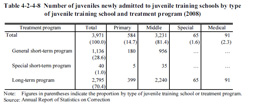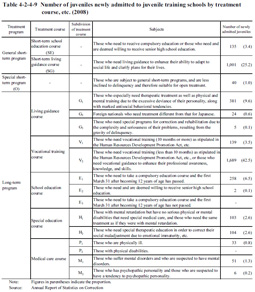| Previous Next Index Image Index Year Selection | |
|
|
2 Treatment at juvenile training schools (1) Individualized treatment and classified treatmentTreatment according to individual needs is conducted at juvenile training schools (individualized treatment) after taking each person’s personality, strengths, future plans, physical and mental condition, and delinquent tendencies, etc. into full consideration. In achieving the goal of individualized treatment, scientific examinations are conducted on each juvenile, with juveniles displaying common characteristics and educational needs classified into groups and each group provided with the most appropriate treatment (classified treatment). In addition, treatment is provided by setting goals, content and methods according to the progress made in each juvenile’s reformation and with the aim of facilitating the juvenile’s reformation through raising motivation to make voluntary efforts. The treatment at juvenile training schools is divided into the three educational stages of orientation, intermediate, and pre-release. Distinctive educational goals and content are set for each stage. The treatment of juveniles is divided into the first to third grades, with the first and second grades being divided again into two (upper and lower grades). Newly admitted juveniles are first placed in the lower second grade and then move on to the other grades according to the progress they make in their reformation. (2) Type of juvenile training schools and treatment programs Newly admitted juveniles at juvenile training schools are classified/organized by [1] type of juvenile training school, [2] treatment program, and [3] treatment course, all according to their individual characteristics and educational needs. a. Type of juvenile training schools The following four types of juvenile training schools are used to accommodate juveniles according to their age, level of criminal tendency, and physical and mental condition: [1] Primary juvenile training schools: Juveniles generally aged 12 or older but usually younger than 16 and without serious physical/mental disability; [2] Middle juvenile training schools: Juveniles generally aged 16 or older but younger than 20 and without serious physical/ mental disability; [3] Special juvenile training schools: Juveniles generally aged 16 or older but younger than 23 and without serious physical/mental disability, but with a strong criminal tendency. However, juvenile inmates sentenced to imprisonment younger than 16 may also be accommodated; and [4] Medical juvenile training schools: Juveniles generally aged 12 or older but younger than 26 and with serious physical/mental disability. b. Treatment programs Juvenile training schools establish treatment programs that are defined by the administrative term of confinement. Both short-term and long-term programs are available, with the former being divided into general short-term programs and special short-term programs. Primary juvenile training schools and middle juvenile training schools implement both short-term and long-term programs, but special juvenile training schools and medical juvenile training schools implement long-term programs only. The programs are implemented for the following juveniles: [1] General short-term programs: Juveniles who can be expected to be corrected and reintegrated into society through continuous and intensive short-term training as they are very likely to be reformed promptly (maximum term of confinement is in principle six months); [2] Special short-term programs: Juveniles who are subject to [1], but are less inclined to delinquency and therefore suit open treatment (maximum term of confinement is four months); [3] Long-term programs: Juveniles who are not suitable for short-term programs (maximum term of confinement is in principle two years). Table 4-2-4-8 shows the number of juveniles newly admitted to juvenile training schools in 2008 by type of juvenile training school and treatment program. Table 4-2-4-8 Number of juveniles newly admitted to juvenile training schools by type of juvenile training school and treatment program (2008) c. Treatment coursesTable 4-2-4-9 shows the type and subject of treatment courses and the number of juveniles newly admitted to juvenile training schools by treatment course, etc. in 2008. Table 4-2-4-9 Number of juveniles newly admitted to juvenile training schools by treatment course, etc. (2008) (3) Contents of educationa. Living guidance Living guidance is implemented on the following issues: [1] problems related to juveniles’ ways of thinking, attitude, and behavior that could lead to delinquency, [2] problems related to juveniles’ predisposition and emotions, etc., [3] problems related to the cultivation of aesthetic sensitivity, [4] problems related to juveniles’ basic life style, law-abidance and self-disciplinary behavior, and interpersonal relationships, etc., [5] problems related to home environment (relationship with juveniles’ families and friends, etc.), and [6] preparation for career selection, life planning, and social reintegration through various methods such as counseling, writing essays and a diary, and role lettering, etc. In addition, “education from the victims’ point of view” programs have been improved and enhanced to help juveniles to understand the actual damage caused by the offense or delinquency they committed and the victims’ feelings, etc. and thus be able to respond to a victim more sincerely. b. Vocational guidance Juvenile training schools currently offer vocational guidance on courses that include welding, woodwork, civil engineering and construction, operation of construction machinery, agriculture and horticulture, office work, and caretaking services, etc. In 2008, 44.9% of discharged juveniles obtained qualifications or licenses related to their vocational guidance course, while 50.7% obtained qualifications or licenses not related to their vocational guidance course. Fig. 4-2-4-10 shows the percent distribution of discharged juveniles by qualification/license obtained in 2008. Fig. 4-2-4-10 Percent distribution of discharged juveniles by qualification/license obtained (2008) Since FY 2006 the Ministry of Justice in cooperation with the Ministry of Health, Labor and Welfare has been implementing comprehensive employment support measures. As part of those measures, vocational counseling, etc. by public employment security office staff members has been implemented (See (1) of Subsection 3, Section 1, Chapter 4, Part 7).c. Academic education Juveniles at juvenile training schools who did not complete their compulsory education and those who need or wish to receive senior high school education are placed in academic education courses and receive academic education. Academic education is provided also for other juveniles as supplementary education to meet their needs, such as the basic scholastic abilities needed in leading a social life or the scholastic ability development needed to proceed to a higher education or return to the school to which they previously belonged. Some institutions implement compulsory education or senior high school education through academic education programs entrusted to schools, etc. outside the juvenile training school. Of juveniles discharged in 2008, 142 returned to junior high school and 130 to senior high school. A total of 316 juveniles received graduation certificates from their junior high schools while in a juvenile training school (Source: Annual Report of Statistics on Correction). Since FY 2007 the Certificate for Students Achieving the Proficiency Level of Upper Secondary School Graduates (high school equivalency examination) has been available to take at juvenile training schools. In FY 2008, 326 juveniles took the examination and 88 passed the examination, with 227 passing at least one subject (Source: The Lifelong Learning Policy Bureau, Ministry of Education, Culture, Sports, Science and Technology). d. Health and physical education Doctors and medical staff of juvenile training schools provide health education on disease prevention, etc. to enhance juveniles’ ability to maintain good health, with consideration given to their previous delinquency and actual living conditions, etc. Various sporting activities are implemented through physical education to enhance basic physical abilities, concentration, patience, and endurance, while group games are utilized in order to develop the ability to comply with rules and cooperate in interpersonal relationships, etc. e. Special activities Special activities include [1] voluntary activities, [2] extramural educational activities, [3] club activities, [4] recreation, and [5] other events implemented at juvenile training schools. As voluntary activities juveniles at most juvenile training schools can be assigned roles such as being the day manager, book manager, maintenance manager, recreation manager, etc. to develop autonomy and cooperativeness. In addition, meetings and homerooms are held and in-house magazines, etc. are published. Social service activities and field trips, etc. are implemented as extramural educational activities. As social service activities many juvenile training schools implement volunteer activities at welfare facilities and cleaning/beautification activities at nearby parks and public facilities, etc. (4) Medical care Of juveniles discharged from juvenile training schools in 2008, 1,115 (27.6%) received some form of medical treatment while at a juvenile training school, inclusive however of those who received treatment at a medical juvenile training school. By type of illness, “respiratory disease” was the highest in proportion at 66.3%, followed by “mental or behavioral disorder” at 10.0% (Source: Annual Report of Statistics on Correction). (5) Measures for guardians, etc. Guardians play a significant role in the reformation/rehabilitation of juveniles, and hence juvenile training schools have consistently provided advice, etc. to them. The November 2007 amendment of the Juvenile Training Schools Act provided the directors of juvenile training schools with appropriate measures including providing guidance, advice, etc. to guardians. In response to this, juvenile training schools have now been providing guidance and advice that helps guardians to cope with any problems concerning the delinquency of a juvenile, offering information on correctional education, and holding guardian meetings. (6) Cooperation and assistance from the private sector in treatment Wide variety of private volunteers from local community, including volunteer visitors, chaplains, members of the Women’s Association for Rehabilitation Aid and members of BBS associations, etc., are often involved in support activities at juvenile training schools. Volunteer visitors provide juveniles with advice and guidance on mental problems along with cultural guidance, etc. As of December 31 2008, 648 persons were commissioned as volunteer visitors to juvenile training schools (Source: The Correction Bureau, Ministry of Justice). Chaplains can provide religious education upon the request of juveniles. As of December 31, 2008, juvenile training schools had a total of 376 chaplains available (Source: The Correction Bureau, Ministry of Justice). Members of the Women’s Association for Rehabilitation Aid and members of the BBS associations support educational activities at juvenile training schools in a variety of ways. They regularly visit juvenile training schools to participate in school events such as birthday parties, cherry blossom viewing parties, and Coming of Age ceremonies, play games and sports with juveniles, or participate in debates as judges. Interaction with these volunteers serves as significant encouragement to juveniles to rehabilitate themselves. |


